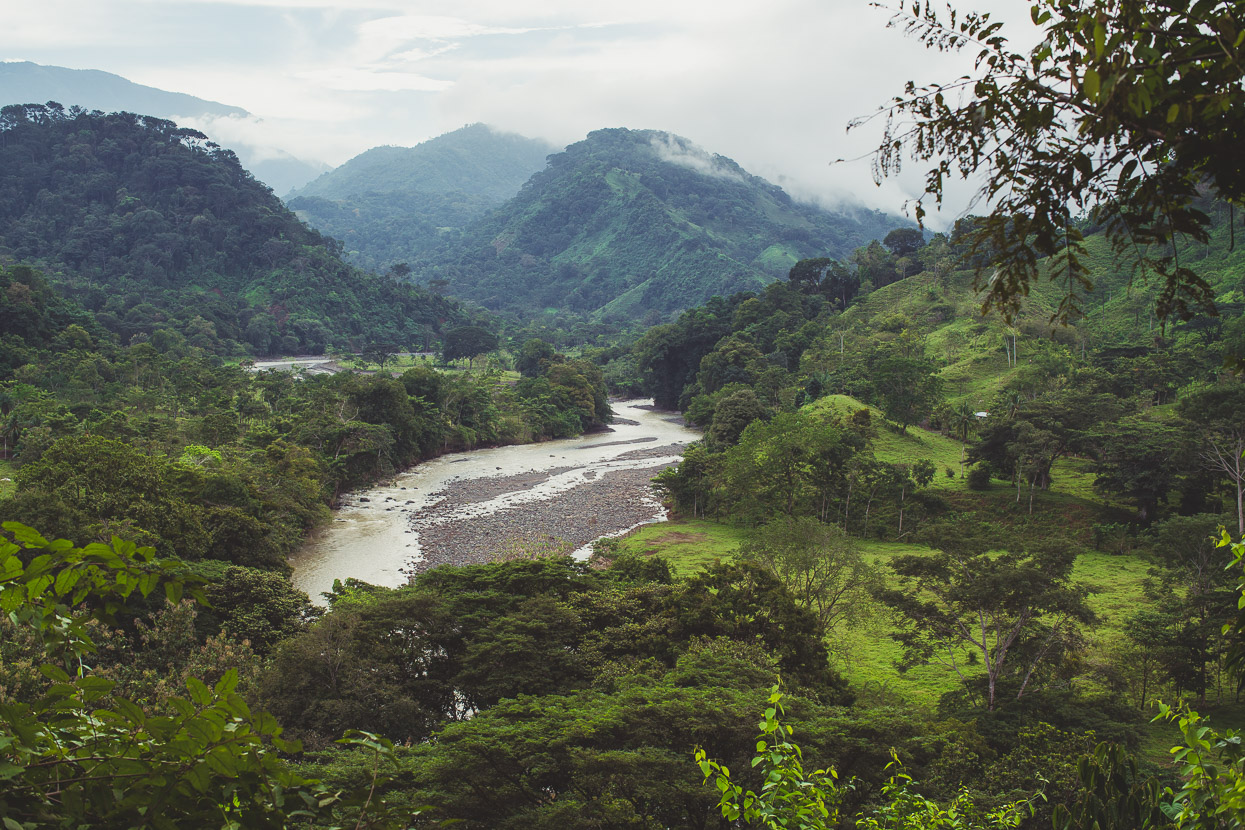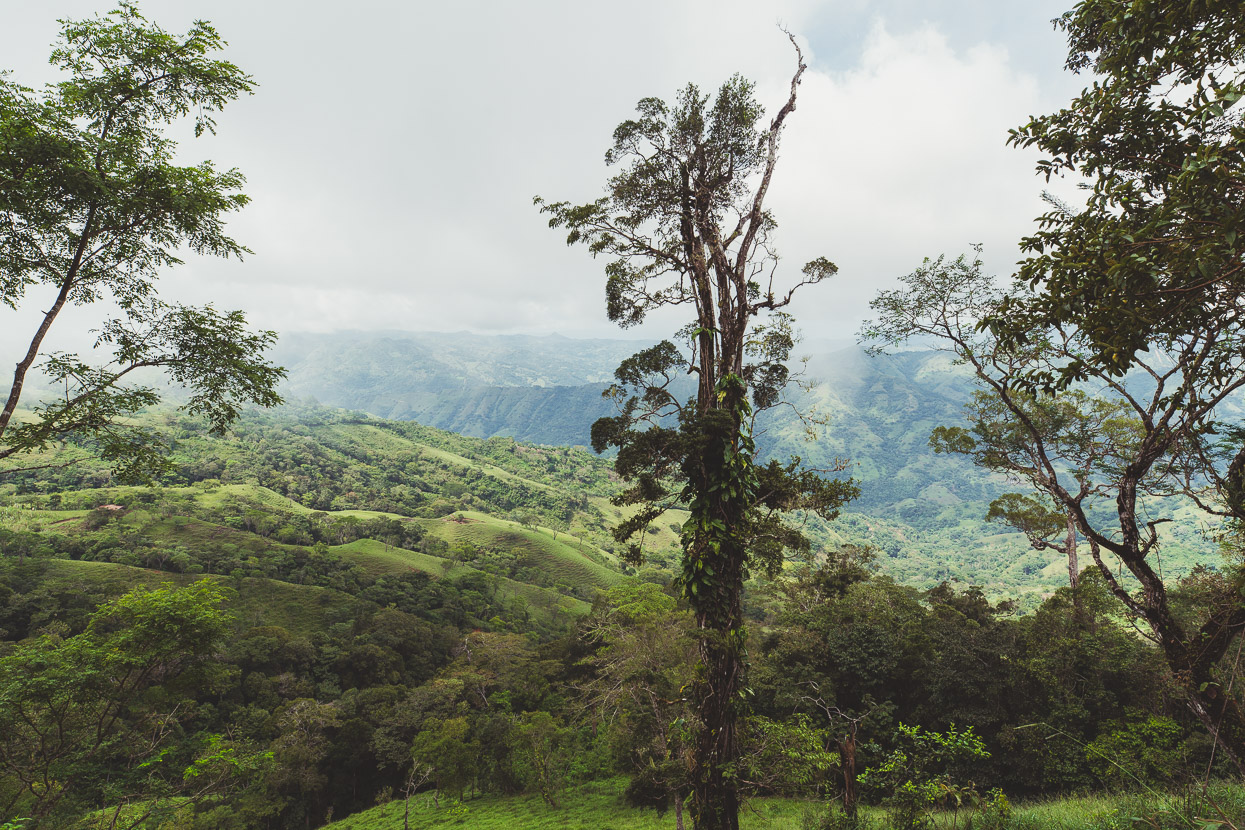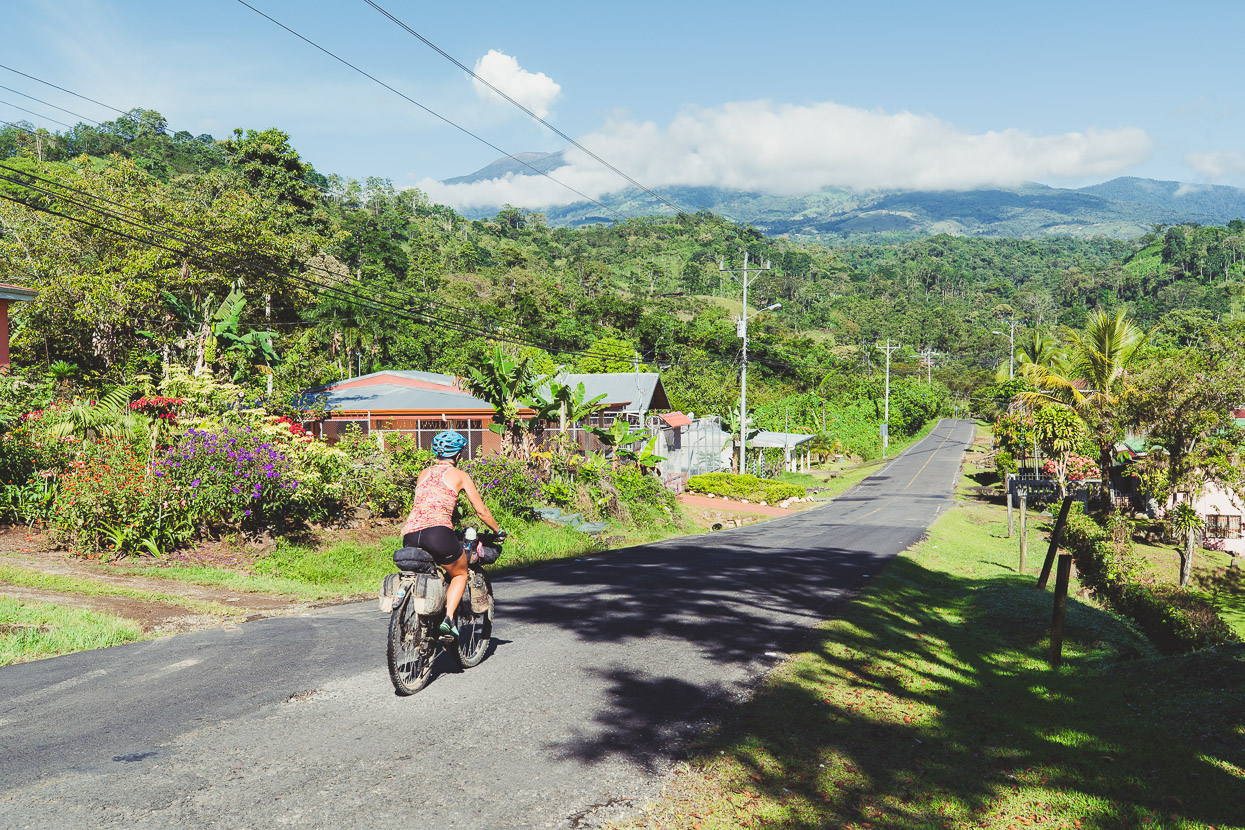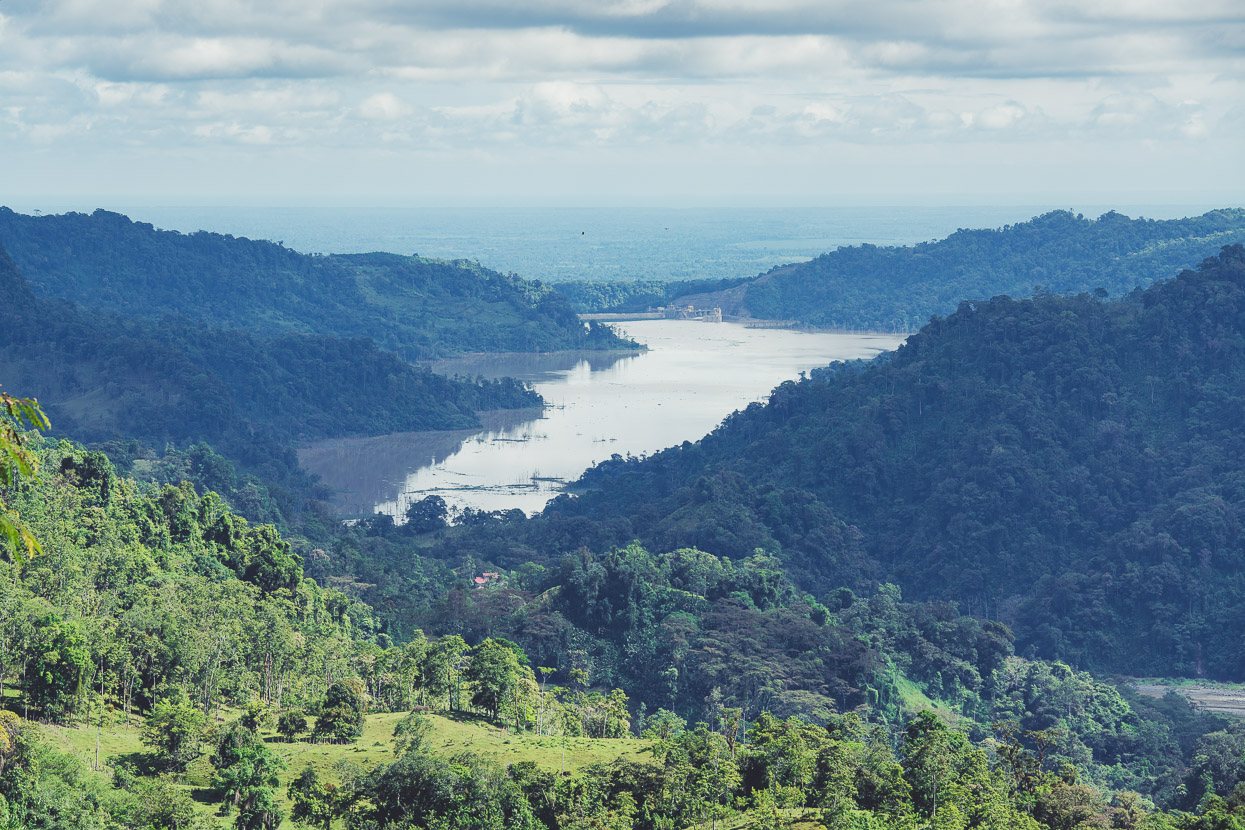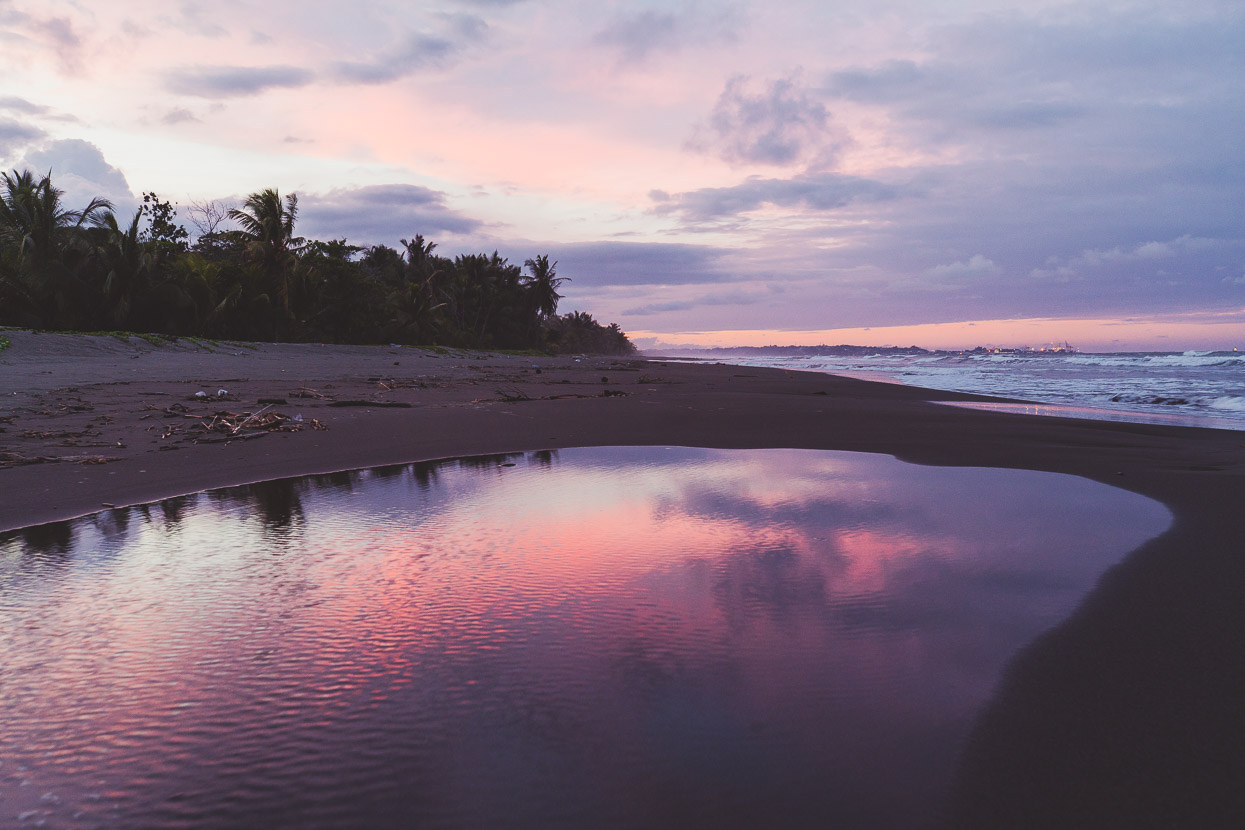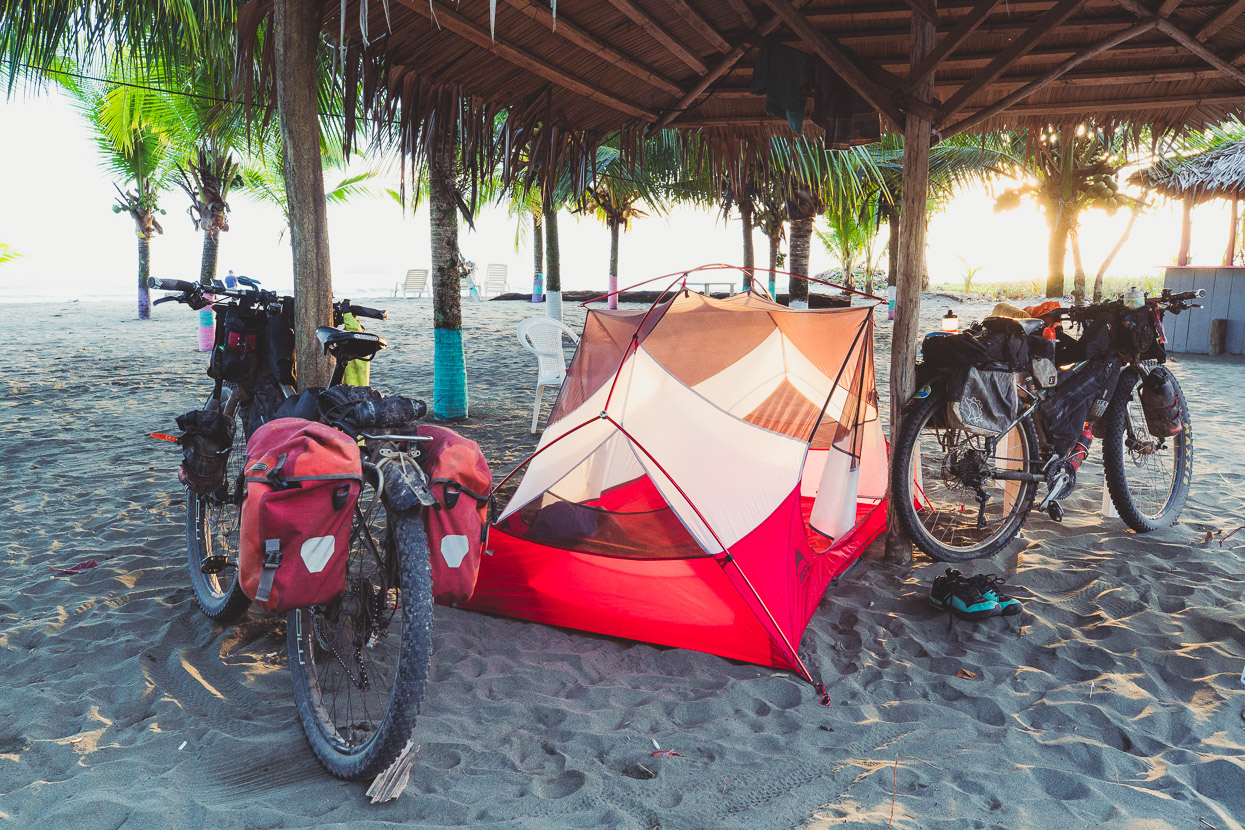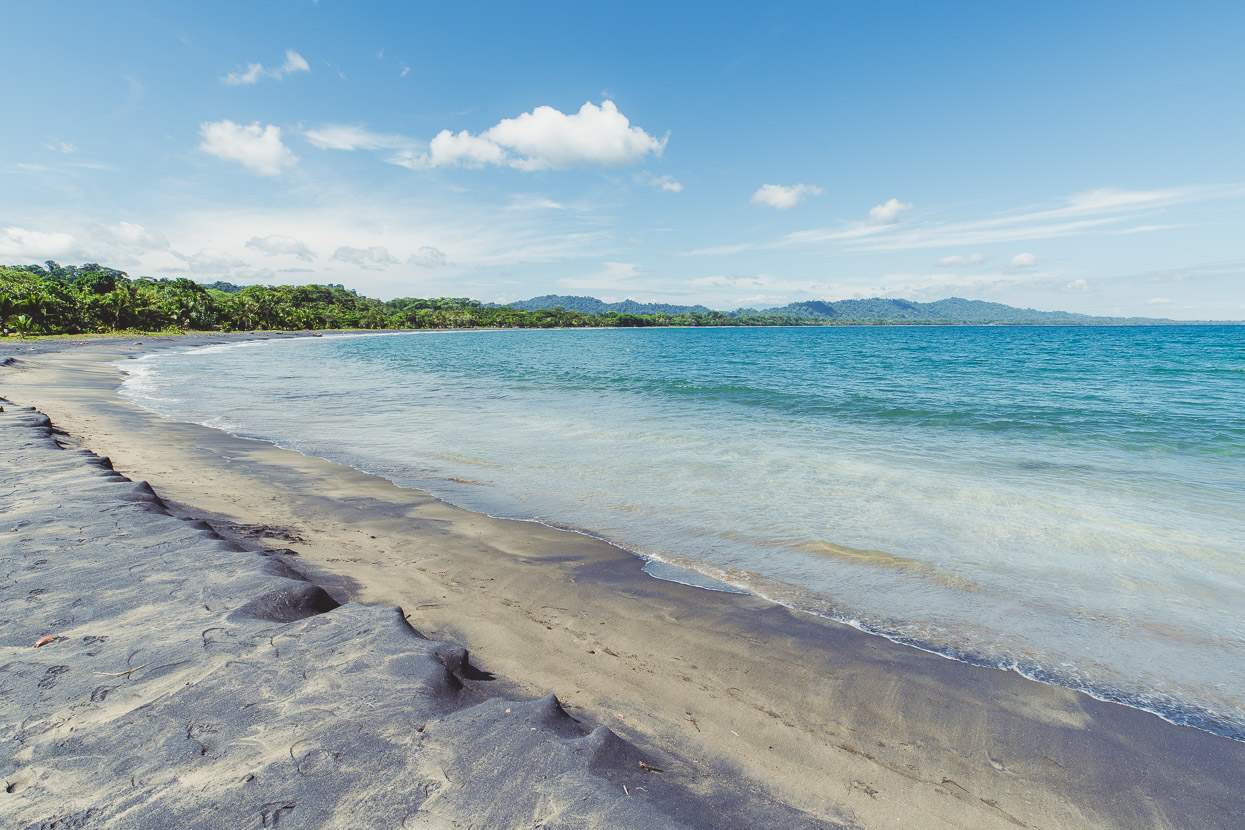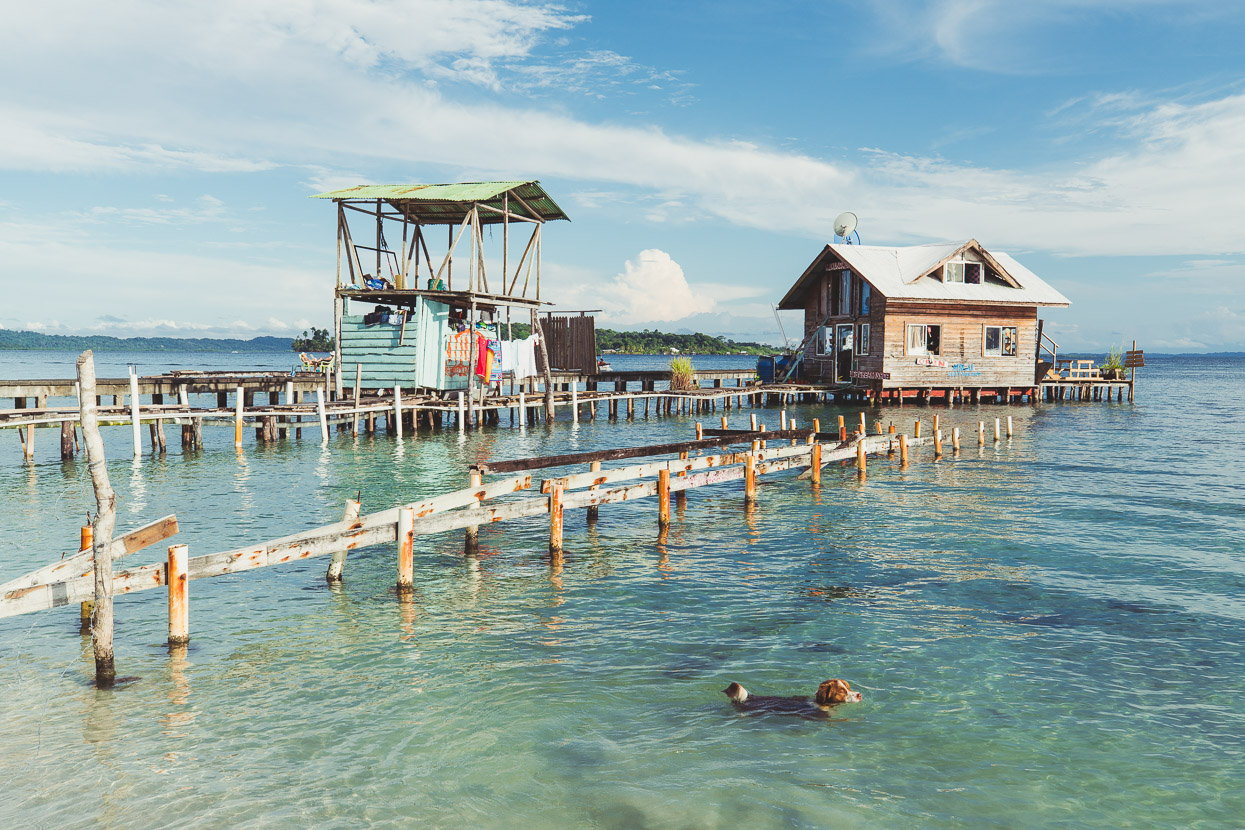The Final Time Trial.
Our closing post from Central America, this collection of photos covers the 1116 km that we rode in 12 days from the peninsula town of Punta Arenas in Costa Rica down to Panama City.
Back on the Nicoya Peninsula we’d deliberated about plans for the remainder of our ride in Central America – we only had 12 days left to get to Panama City for our flight to Cuba, which could mean a relatively casual cruise – mostly down the Pan American Highway – with shorter days and time for a bit of relaxing as we headed south.
The alternative, we figured, was an ambitious double crossing of Central America’s dividing cordillera – taking us through Costa Rica’s fabled coffee country, to the jungly and remote Caribbean Coast of Panama and then back to the Pacific side, finishing with a final 438 km down the Pan American to Panama City. We reckoned with an average of 101km/day plus one day off we’d be sweet – figuring that the average might be hard to attain in the hills, but that we could make it up on the flats of the Caribbean Coast and the Pan American.
Of course we chose the latter.
Well accustomed as we are to slightly seedy digs, this was our stop for the night in Punta Arenas after the Nicoya ferry berthed in the dark. Compared with the rest of Central America though, Costa Rica’s expensive when it comes to food and beds, and even a cheap hotel room is likely to set you back US$30 – $35.
We almost felt like fish out of water taking the wide highway south down the coast towards Parrita, where we planned to turn inland.
But it wasn’t all 18-wheelers and SUVs, once again we were amazed by Costa Rica’s scenery – and its wildlife. I counted about 21 big crocodiles from this highway bridge, casually snapping their prodigious jaws and moving silently around in the water. Later as we rode a hillier section close to the sea scarlet macaws flew overhead and sat in the trees near the road.
Looking back from the road into Playa Jaco. While the coast and headlands are scenic, tourism and the demand for coastal property has created a few eyesores in Costa Rica. We pass by Playa Blanca along this coast – used as a location in the Ridley Scott-directed Christopher Columbus epic 1492, because of its utopian scene of a golden sand beach framed with jungle.
We didn’t have time to explore though, just stopping briefly at Playa Esterillos, a windswept section of coast further south.
After a night in Parillas we turned onto dirt roads crossing the wide coastal plain towards the steeps of Costa Rica’s Cordillera Central. It’s always saddening to see what would have been beautiful lowland rainforest levelled for palm oil plantations, which lined the road in solemn uniformity. If you have the option to avoid palm oil in food products, do so; the demand for this product in the food industry is one of the biggest factors in rainforest destruction worldwide.
But as we near the hills scraps of old growth forest start to appear.
Plentiful in Costa Rica is clean water and it’s great to be able to drink it from the tap in many places (unlike much of the rest of Central America). We often collect water from these AYA community wells when we see them.
Between us and the city of Limón on the Caribbean coast (three days ride), lay over 6000 metres of elevation gain, and we climbed over 2600 metres on the first day over 60 kilometres – it’s big country!
We picked this route as the other highways into the hills from the Pacific Coast were paved and considerably busier with traffic. This route kept us on quieter (albeit later paved) roads for much longer. Aside from some brutally steep sections, it was a great choice of route leading us though some spectacular hill country as it climbs into the Cordillera.
Occasionally the road offered these glimpses out to rugged hill country, covered in jungle. A reminder of some of the landscapes back home in NZ.
Looking back – as I write this, rested and well fed in Cartagena – this looks like a colossal meal to eat for lunch. But I recall we ate one of these each easily with juice and coffee after climbing the first 1000-odd metres of the day before heading on to much more climbing in the afternoon. Our appetites amaze us sometimes.
After the first range the road undulated and then dropped steeply to the big, roaring and bouldery Rio Candelaria before climbing very steeply out of the valley on pavement. This house, destroyed by a landslide, was a reminder of how widespread the damage from October’s Tropical Storm Nate had been.
The wide angle lens mellows the steepness of this slope, but this relentless climb was the steepest paved highway we’ve ever ridden. To keep momentum and not tear our kneecaps off we zig zagged like crazy most of the way up.
That night we slept we in Vuelta de Jorco, taken in by the friendly community and offered the town hall to sleep in. But before settling down for the night the police invited us into their humble station and fed us coffee, gallo pinto (the ubiquitous rice and beans) and salad. The short, frowning fellow to Hana’s left had a very squeaky voice and when the officer in charge told him to take care of us his reply sounded so funny that Hana laughed, assuming he was putting it on for our amusement.
We were seated at a small table, locked inside the small station, while the man made our food in a flurry of activity, mumbling to himself and occasionally turning to us to communicate with a combination of miming and barely understandable high pitched Spanish. It was all wonderfully odd and very, very generous.
The following day our legs were wrecked from the prior day’s steep climbing, but the steeps continued, although in much shorter sections. We were well into coffee country now; the bright, ripe, coffee cherries vibrant among hillsides thickly covered in coffee plantations.
We reached the highpoint of the Cordillera, at just under 2000 metres and joined the Pan American Highway, down which we freewheeled a long and windy descent to the central valley. Volcan Irazu (3432m) dominates the valley and its bulky summit was swallowed in afternoon cloud while the city of Cartago lay sprinkled across the flats and up its lower slopes.
We stopped in Cartago only for lunch and a quick look at the town plaza, which is dominated by the Santiago Apóstol Parish Ruins – a Costa Rican cultural heritage site. The ‘ruins’ are actually one of a series of churches that were built on this site and subsequently ruined by earthquakes. The present building is not a ruin technically – its construction was simply abandoned after the 1910 Santa Monica earthquake. Today it’s a shady spot for strolls, picnics and meeting friends.
From what we saw of it Cartago looked like quite a hip city with quite a lot of interesting architecture – a nice place to spend a couple of days if you have the time.
After the richly colourful cemeteries of Guatemala, Honduras and Nicaragua, Costa Rica’s are a style all of their own.
While we longed to ride our bikes high on Volcan Irazu we simply didn’t have time, instead following a sometimes busy paved highway through woodlands, sugar cane fields and agricultural company towns.
Like Cartago, Turrialba had some distinctive architecture and both places seemed to have an aesthetic all of their own – unlike the colonial cities we’re used to seeing in Central America.
From Turrialba we got onto a much quieter road that wove its way through the rainforest covered lower slopes of the volcanic massif of Irazu and its neighboring peak Turrialba, smoking away in the background. It was an excellent choice of road – devoid of traffic, narrow and winding as it followed the spurs and valleys of these big volcanoes.
Occasionally we snatched a view out to the coastal plain, the Caribbean sea just visible through the haze.
This section was rich with bird calls and the sound of the river coursing through a deep gorge just ahead, while skinny trees stood tall overhead.
And finally the rolling road through convoluted mountain country was over and we coasted down to the flats.
The road beyond – to the busy port city of Limón – often hugged the base of the hills and was incredibly scenic, with tea-coloured streams, high canopy jungle and few settlements, but sadly it was hellishly busy with trucks. There was usually no shoulder and we spent a tense afternoon being buffeted by the slipstream of these relentless vehicles, which often passed us with no regard at all for our space. Several times we ‘bailed’ off the road onto the grass or gravel when we felt like one was just too close, or when they were overtaking and we had two 18-wheelers side-by-side headed for us.
The day ended on a good note though when in Limón we hit the coast finally and the road quietened. We casually rode further east with a tailwind and stopped for the night to camp at a beachside restaurant.
The road beyond was beautiful, with primal forest and wetlands merging seamlessly as we crossed rivers and estuaries. To our right the forest continued unbroken right to the crest of the Cordillera de Talamanca and settlements along the road were few. Some households had small coconut oil stands set up.
Somehow the beautiful beaches of Puerto Viejo had been off our radar, and as soon as we pedalled into this laid back village we were tempted to stay. It’s a pocket of tourism in an otherwise very quiet and remote place, but the vibe and scenery here is quite special. We made do with a coffee and the idyllic Caribbean view north west along Playa Negra. To anyone following on our tyre tracks: stay here!
Instead we pushed on towards the famous Bocas Del Toro and for a time the pristine scenery gave way to endless banana plantations as we neared the Panama border. Banana’s are the principal industry along this coast and many tiny company towns service the acres and acres of banana fincas (ranches).
The border crossing went smoothly and soon we were in Panama (country number 9 of this trip).
After a hilly end to the afternoon we coasted down into the scruffy port town of Almirante and caught the last boat of the day (in the nick of the time) out to Bocas del Toro, one of several islands of a region of the same name, translated: Mouths of the Bull. This area’s famous for its African Afro-Caribbean people who are based mostly on the islands, and several other indigenous indian groups who live on the mainland, the Ngöbe-Buglé, Naso and Bribrí.
An incredible biodiversity, both land and marine-based exists here, but most people come for the special Caribbean island atmosphere, to party and absorb the unique culture.
Leaving Almirante on the water taxi we passed homes built over the water – reminding us of the floating river towns we’d seen in Cambodia.
All those bananas we passed on the highway have to be shipped somehow.
Our sole rest day on this 1116 km stretch from Punta Arenas to Panama City was spent at Bocas Del Toro and we were content to chill out, eat food and do our laundry. I got the feeling Bocas is best seen with a few days at hand and the money to spend on water taxis out to different parts of this island complex. That said, it was well worthwhile heading out there for its uniqueness.
We found lunch at a caravan on the main tourist street where a cheerful buxom woman with big hands and an even bigger afro served us a lunch of fried pork, gallo pinto and salad eaten sitting on wobbly wooden stools. We found the main town a bit too touristy for our liking, with high prices and a veneer that had glazed over the traditional charm of the township. In the afternoon we caught a 5 minute water taxi and wandered around a small nearby island, swimming in the bath-warm water.
Beautiful coastal forest on Isla Carenero.
Back on the mainland after two nights we were soon passing indigenous settlements surrounded by rainforest as we headed towards a quiet and remote corner of Panama, serviced by a single highway that crosses to the Pacific side of the country – our route.
These children are spreading a harvest of cacao (raw cocoa) to dry and ferment after separating the seeds from the fruit.
With few services or villages in this area we take what we can get for food: coconuts, fresh bread and bananas.
Towards the end of the day in Rambala we were sitting outside a shop deciding whether to ride on or try and sleep there when a man selling ice creams from the back of his motorbike got talking to us.
Angel invited us back to his house to sleep in a spare room. His wife Maria cooked us dinner and showed us her amazing pet loros while Angel told us a great story about how he’d met another touring cyclist 8 years ago and teamed up with him to ride the rest of the way to Panama city.
Between us and the Pacific lay another crossing of the Central Cordillera, although this time it was a much more merciful gradient as we climbed through the area’s unique forests and small indigenous communities, heading forever upwards on the ribbon of road.
As we neared the divide drizzle set in, which turned to steady rain as we descended the other side of the range back down to sea level at the Pacific. This side was much more modified. Gone were the endless forest covered hills and wooden huts, replaced with fincas, farmland and roads. By the time we reached the junction with the Pan American Highway the rain was heavy and unrelenting, pouring off the roofs of buildings and down the sides of the road like a river.
We decided an early dinner might be a good call, simply for the sake of some shelter and to sit it out and see if it eased. An hour before sunset it had eased a little, but it wasn’t camping weather and there was nowhere to stay nearby so we rode down the highway to the Bomberos station we’d seen on the map. Bomberos are basically the fire service in Central America, although sometimes the stations are large and combine emergency services. This was a tiny one, with one very small fire truck and a three room station with two bomberos on duty. Asking to sleep at these stations is common among cycle tourists and generally you are accepted and looked after, no questions asked.
The boss wasn’t too keen to have us at first though, telling us that the last time he’d let travellers sleep there, some police had come by with a drug dog (by chance) and discovered that their guests were ironically drug smugglers. But with the pouring rain he felt sorry for us and suggested we pitch our tent under a tin shelter out the back of the station on the proviso that we leave before 6am (before the next shift started).
We were asleep by 7.30 pm that evening as the rain drummed incessantly on the tin roof and by 5.45 am in the morning we were clicking into our pedals outside the station, the rain eased to a drizzle. It was still dark. We started pedalling down the surprisingly quiet Pan American Highway. By lunchtime we’d ridden nearly 100 kilometres and by dark, after nearly 10 hours moving time, we’d done 178 kilometres. A new record for us, both in distance and duration on a bike tour. With a combination of the nearly-continuous rain keeping our muscles cool and the easier riding we felt like we could ride forever that day.
We stopped at a cheap Chinese owned hotel in Santiago de Veragua for the night. It was no reward for the long day. The room hadn’t been properly cleaned in years, with slime in the bathroom and empty beer cans under the bed. But we didn’t care too much – we’d had a worse room in Nicaragua at a filthy pay-by-the-hour ‘Sexy time Hotel’ where used condoms were scattered in the courtyard.
But during the night we were woken to the sound of keys in the door and incoherent mumbling outside. Whoever was outside opened the door about halfway, rambling as if drunk, only to have Hana – who was closest the door – slam it shut and tell them to get lost. It was all a bit strange. Why on earth was a drunk person with hotel keys trying to get into our room? It was unnerving, but we went back to sleep, only to wake sometime later with two people outside the room talking and rattling keys. We both leapt out of bed and leaned on the door yelling at the intruders, who then quietened down. The second attempt was enough that we turned the whole bed around and jammed it against the door. We needed our sleep.
In the morning it was as if nothing had happened and we sat in the motel forecourt area using the wifi before we left for another 100 km day.
Mostly the Pan American lies well inland of the coast, but it gets close to the sea at Playa Santa Clara so we nipped down for a look and a coffee and pancake at the beach resort.
Finally after two and a half more days of riding we crossed the Bridge of the Americas to Panama City.
While parts of the Pan American had been tedious, noisy and sometimes dirty as we closed in on the city, the easy and fast riding further north on the highway had in some ways been a reward for the labour of the previous months – a time to spin the legs and reflect and absorb the intensity of our experiences. Since leaving Copan, back at the Guatemala-Honduras border nearly two months earlier we’d had many long days and not had more than one day off at a time – and roughly only one a week. It had been a long haul and a rollercoaster of experiences.
Change in one’s philosophy can sometimes be barely perceptible. Once we got over the novelty of the view of high rises, Panama City came as a shock to the senses, our wallets and our sharpened perceptions of consumption and materialism. We were amazed by the visual assault of advertising, the glitzy malls full of mostly unnecessary consumer products, and the price of everything. It was a discovery really, to arrive in a big city and realise that in 17 months on the road we had changed: our sense of priority, of what is important and what is not and our understanding of what creates happiness.
Much is made of peoples’ possessions and privilege; the haves and have nots, but one thing we have come to realise from over a year of travel in the rural areas of North and Central America is that those with few material possessions – those without running water or a floor in their home – seem just as happy, if not happier than the families who spend their leisure time and disposable income in the mall. And often it’s those with the least who have been the most generous to us. We’ve come to realise more clearly the good in simple acts and small things.
We were in Panama City three nights, but it was hardly a relaxing time. We were off to Cuba for a month from there, so needed to get the bikes serviced (at two different shops) find bike boxes to pack the bikes into for the flight (surprisingly difficult in a city that has several bike shops), catch up on the blog and buy essential items we would not be able to buy in Cuba.
We were hosted for two nights by Warmshowers Hosts Mateo and Kary and their son Manel, who looked after and fed us generously. It was great to have a home to hang out in after so many nights in hotels, hostels and the tent. Thanks guys!
And finally we flew (via San Salvador) towards the Jewell of the Antilles, Cuba. Below, fluffy clouds capped the peaks and misty strands sat in the troughs of the land that we’d spent the past months grinding and sweating our way over. Little was recognisable below us in the half light, but that view of the rumpled land from above was enough for a cascade of moments and memories to flood my brain. Central America has been an incredible chapter of our trip – one that’s blown away the prejudices and fears imbued by outsiders and allowed us to form our own opinions and knowledge about lands and people new to us. We leave with many moments embedded in our minds, moments that continue to shape who we are and the way we’ll move forward into South America. Such is the reward of travel.
Do you enjoy our blog content? Find it useful? We love it when people shout us a beer or contribute to our ongoing expenses!
Creating content for this site – as much as we love it – is time consuming and adds to travel costs. Every little bit helps, and your contributions motivate us to work on more bicycle travel-related content. Up coming: camera kit and photography work flow.
Thanks to Biomaxa, Revelate Designs, Kathmandu, Hope Technology and Pureflow for supporting Alaska to Argentina.












